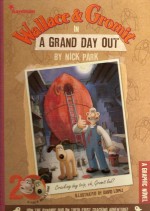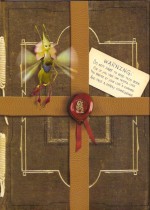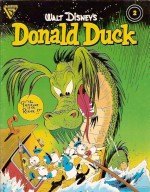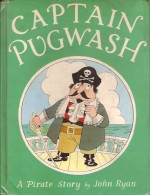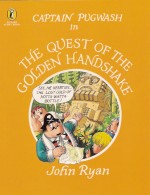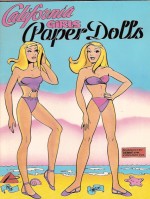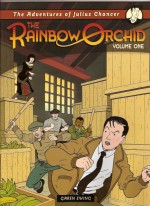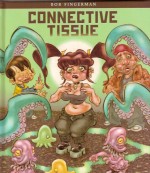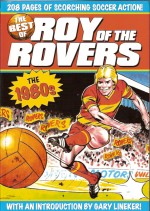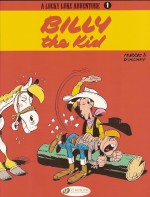
By Morris & Goscinny, translated by Luke Spear (CineBook)
ISBN: 978-1-905460-11-3
It’s hard to think of one of Europe’s most beloved and long-running comics character’s being in any way controversial, but when the changing times caught up with the fastest gun in the West (“so fast he can outdraw his own shadow”) and Lucky Luke moved with them, the news made headlines all over the world.
Lucky Luke is a rangy, laconic, good, natured cowboy who roams the fabulously mythic Old West, having light-hearted adventures with his horse Jolly Jumper and Rantanplan (“dumbest dog in the West” and a charming spoof of cinema canine Rin-Tin-Tin), interacting with a host of historical and legendary figures of the genre.
His continued exploits over more than 60 years have made him the best-selling comic character in Europe, (more than 300 million albums in 30 languages thus far), with spin-off games, computer games, animated cartoon and even live-action movies.
He was created by Belgian animator, illustrator and cartoonist Maurice de Bévère – who signed himself Morris – for the 1947 Annual (L’Almanach Spirou 1947) of Le Journal de Spirou, launching into his first adventure ‘Arizona 1880′ on December 7th 1946.
Before then, while working at the CBA (Compagnie Belge d’Actualitiés) cartoon studio Morris met future comics super-stars Franquin and Peyo, and worked for weekly magazine Le Moustique as a caricaturist (to my eyes Lucky Luke looks uncannily like the young Robert Mitchum who graced so many mid-1940s B-movie Westerns).
He quickly became one of “la Bande des quatre” or Gang of Four, which comprised the creators Jijé, Will and his old comrade Franquin, and who were the leading proponents of the loose and free-wheeling artistic style known as the “Marcinelle School” which dominated Spirou in aesthetic contention with the “Ligne Claire” style used by Hergé, EP
Jacobs and other artists in Tintin Magazine.
In 1948 the Gang (all but Will) visited America, meeting US creators and sightseeing, and Morris stayed for six years, meeting René Goscinny, scoring some work from the newly formed EC sensation, Mad, and making copious notes and sketches of the swiftly disappearing Old West. His research henceforward resonated on every page of his life’s work.
Working alone until 1955 when he reunited with Goscinny (see our recent Iznogoud review for the low-down on that most prolific of comics writers) Morris produced another nine albums worth of affectionate sagebrush parody before, working in perfect unison, Luke attained the dizzying heights of superstardom, commencing with ‘Des rails sur la Prairie’ (Rails on the Prairie), which began in Spirou on August 25th 1955.
In 1967 the straight-shooter switched teams, leaving Spirou for Goscinny’s magazine Pilote with the tale ‘La Diligence’ (the Stagecoach). Goscinny produced 45 albums with Morris before his death, from when Morris continued both alone and with other collaborators. Morris died in 2001 having drawn fully 70 adventures, plus the spin-off adventures of Rantanplan, and the team of Achdé and Laurent Gerra took over franchise, producing another three tales to date. In a most peculiar aside I feel I must mention that Morris was apparently voted the “79th Greatest Belgian” in the 2005 Walloon election of De Grootste Belg. If so, I demand a recount…
Lucky Luke first appeared in Britain syndicated in the weekly comic Film Fun and again in 1967 in Giggle where he was renamed Buck Bingo. In all these venues as well as the numerous attempts to follow the English-language successes of Tintin and Asterix albums from Brockhampton and Knight Books, Luke had a trademark cigarette hanging insouciantly from his lip, but in 1983 Morris – no doubt amidst both pained howls and muted mutterings of “political correctness gone mad” – substituted a piece of straw for the much-traveled dog-end, which garnered him an official tip of the hat from the World Health Organization.
The latest attempt to bring Lucky Luke to our shores and shelves comes from Cinebook, and the first of the twenty (and counting) available albums is Billy the Kid, Morris and Goscinny’s eleventh collaboration.
As Luke rides into the troubled town of Fort Weakling he finds the populace cowed and broken by the vile depredations of the infamous William Bonney. The desperado robs the bank every couple of days, and the stage coach every time it leaves town, helps himself to caramels without paying, and won’t let the saloon serve anything but drinking chocolate.
His deadly aptitude with a six-gun means that no one will swear out a complaint let alone testify against the vicious little bully, and when Luke accepts the job of sheriff it takes brains and cunning rather than his legendary skill with a shooting iron to free the town from the tiny grip of the world’s meanest 12 year old…
Although the dialogue is a trifle stiff in places, this is a grand old hoot in the tradition of Destry Rides again and Support Your Local Sheriff (or perhaps Alias Smith and Jones or Evil Roy Slade are more your style?) superbly executed by master storytellers, and a wonderful introduction to a unique genres for kids of all ages.
And in case you’re worried, even though the interior art still has our hero chawin’ on that ol’ nicotine stick, trust me, there’s very little chance of anyone craving a quick snout, but quite a high probability that they’ll want more Lucky Luke Albums…
© Dargaud Editeur Paris 1971 by Goscinny & Morris. © Lucky Comics. English translation © Cinebook Ltd.
